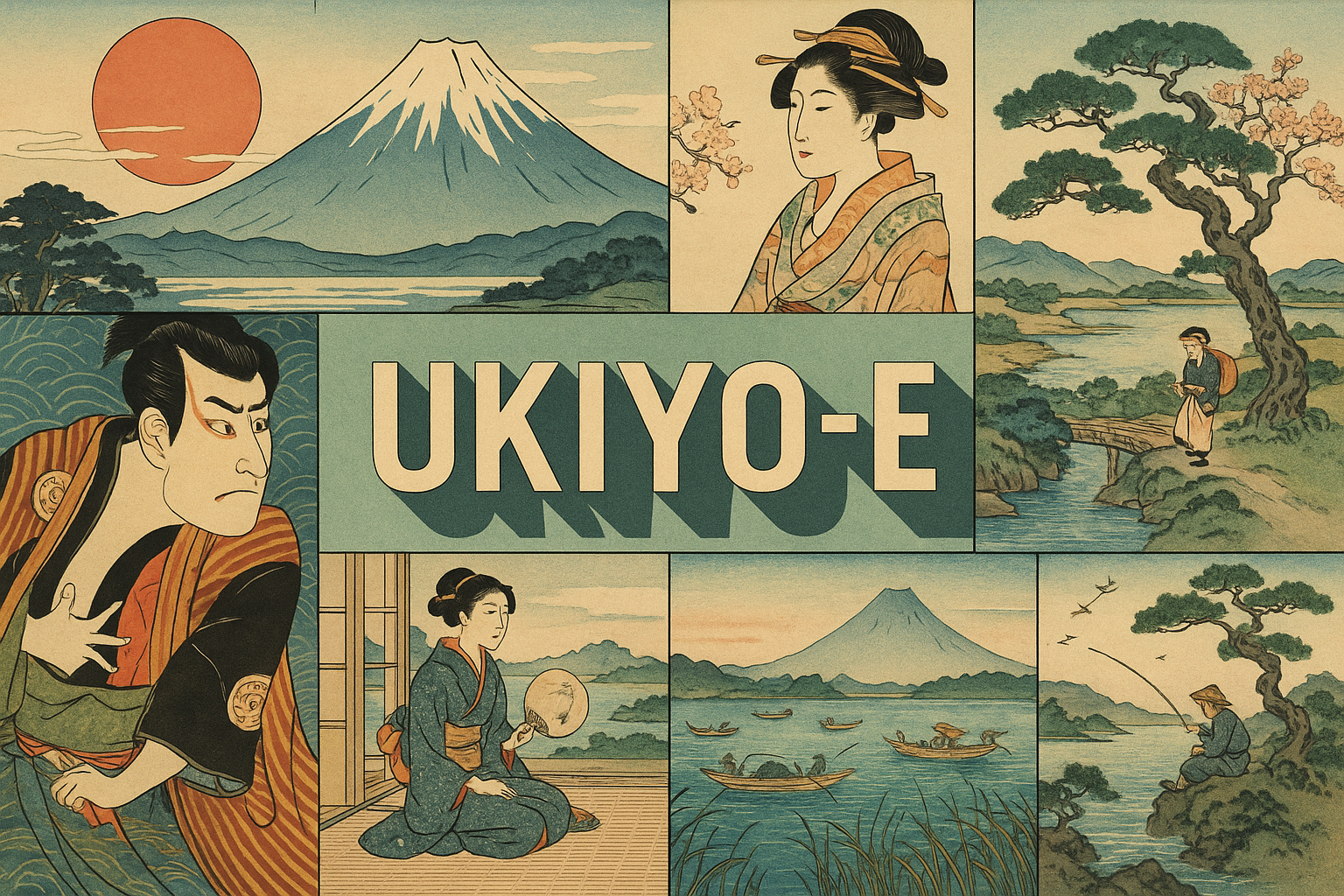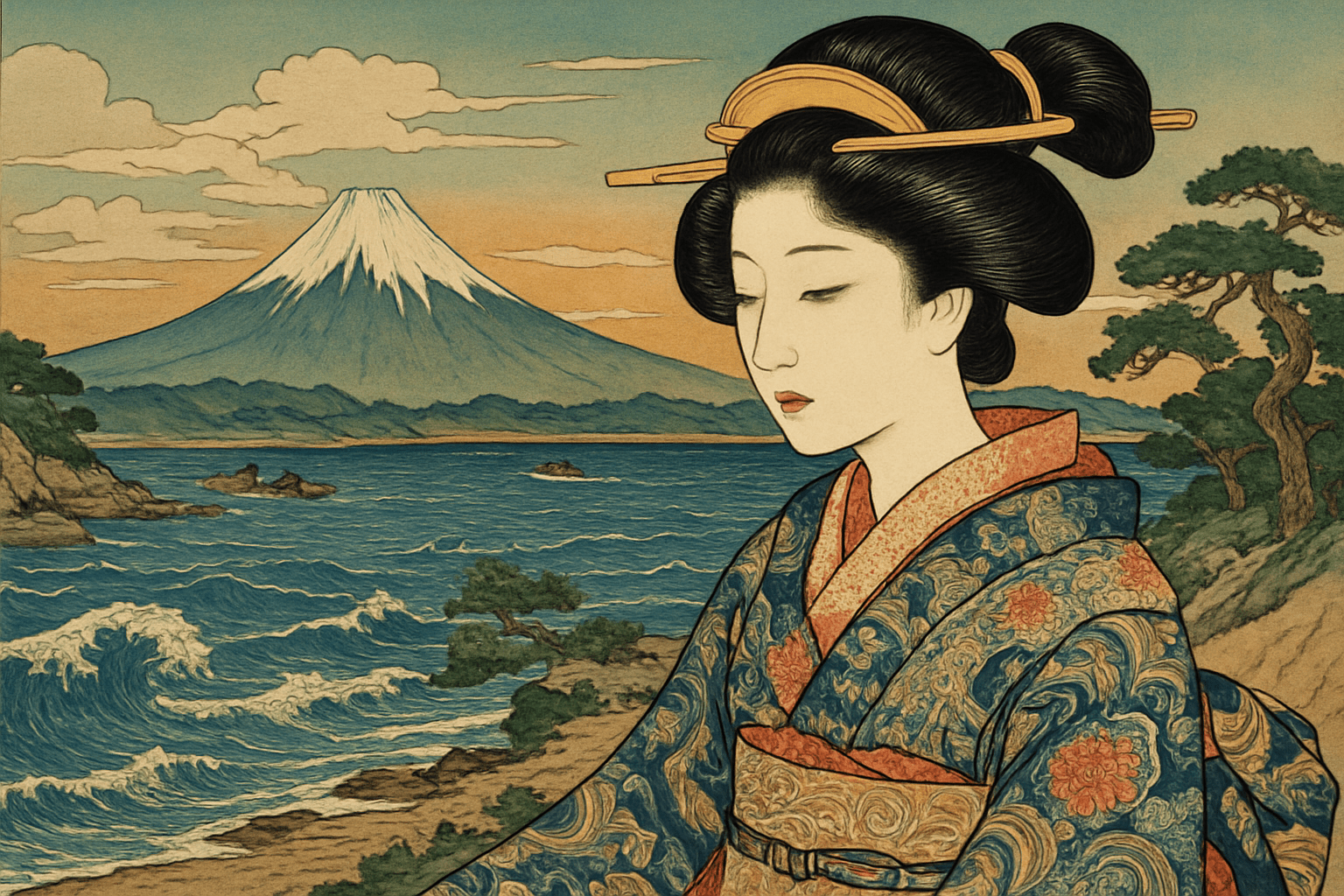
Ukiyo-e
Ukiyo-e is a Japanese art style that is characterized by its woodblock prints. The prints typically depict scenes from everyday life, such as landscapes, portraits, and scenes from literature. The colors are typically very bright and the lines are very clean.
AOI thinking about Ukiyo-e [+_~]-/
Overview and Quickfacts
Ukiyo-e is a Japanese art style that emerged in the late 1600s. It is characterized by its woodblock prints and paintings of everyday life, often with an element of humor or satire. Ukiyo-e reached the height of its popularity in the 1800s, and its influence can still be seen in modern Japanese art and culture.
Can understand it also, as:
Japanese woodblock prints
Categorize it as:
Impressionism, Modernism
.: Dreaming :.
holds a HAIKU for the art style
:. Thought is power .:
Detailed Description
Ukiyo-e is a Japanese art style that emerged in the late 1600s. The term ukiyo-e translates to “pictures of the floating world.” Ukiyo-e artists were known for their woodblock prints and paintings of everyday life, including kabuki actors, geishas, and landscapes. One of the most famous ukiyo-e artists is Katsushika Hokusai, who is best known for his woodblock print series Thirty-six Views of Mount Fuji. Other notable ukiyo-e artists include Utagawa Hiroshige and Kitagawa Utamaro. Ukiyo-e was popularized in the West in the late 1800s by artists such as Vincent van Gogh and Claude Monet, who were both influenced by Japanese art. Today, ukiyo-e is considered one of the most important art styles in Japanese history.
.. beep, beep, beep ..
<START OF TRANSMISSION>
1. Ukiyo-e is a type of Japanese woodblock printing that emerged in the 17th century. 2. Ukiyo-e translates to "pictures of the floating world" and typically depicts scenes of daily life, the natural world, and beautiful women. 3. Ukiyo-e artists often used bright colors and bold compositions to create their artworks. 4. One of the most famous ukiyo-e artists is Katsushika Hokusai, who is known for his woodblock print series "Thirty-six Views of Mount Fuji." 5. Ukiyo-e woodblock prints were very popular in the West during the late 19th and early 20th centuries. 6. Vincent van Gogh, Claude Monet, and other Western artists were influenced by ukiyo-e. 7. Ukiyo-e woodblock prints were mass-produced, making them affordable for the general public. 8. Ukiyo-e became less popular in the early 20th century as Western-style art began to gain popularity in Japan. 9. Today, ukiyo-e is considered an important part of Japanese art history. 10. There are several museums in Japan that specialize in ukiyo-e artworks. 11. The Tokyo National Museum is one of the largest and most important ukiyo-e museums in the world. 12. The British Museum in London also has a large collection of ukiyo-e woodblock prints. 13. Ukiyo-e woodblock prints are typically made on washi paper, a type of traditional Japanese paper. 14. The woodblocks used to print ukiyo-e artworks are usually made of cherry wood. 15. Ukiyo-e artists often used a technique called "keyblock printing" to create their prints. 16. "Keyblock printing" involves carving the main outlines of a design into a woodblock, which is then used to print the design onto paper. 17. Other colors are then added to the print by hand-painting or by using additional woodblocks. 18. It can take several months to create a single ukiyo-e woodblock print. 19. Ukiyo-e woodblock prints were typically sold in shops called "print shops." 20. Today, ukiyo-e woodblock prints are highly sought-after by collectors and can sell for tens of thousands of dollars.
<EOF>
.. robbel bob
Visual Examples from our image gallery
Coming soon, we are so slow .. might never come
Artists, Paintings, and more
(be aware, can be highly speculative)
Artists (be aware, speculation possible):
X
Artworks (be aware, speculation possible)
1. The Great Wave off Kanagawa, Katsushika Hokusai, 1829-1833 2. The Sudden Shower over the Great River, Katsushika Hokusai, 1832 3. Red and White Plum Blossoms, Utagawa Hiroshige, 1833 4. Snow at Kanbara, Utagawa Hiroshige, 1833 5. The Pine Wind at Matsushima, Utagawa Hiroshige, 1834 6. The Moon over Mount Fuji, Katsushika Hokusai, 1834 7. The Rainbow at Shijo Bridge, Katsushika Hokusai, 1835 8. The Plum Orchard at Kameido, Utagawa Hiroshige, 1835 9. The Great Wave off Kanagawa (The Great Wave), Katsushika Hokusai, 1829-1833 10. The Sudden Shower over the Great River (The Sudden Shower), Katsushika Hokusai, 1832 11. Red and White Plum Blossoms (Ume), Utagawa Hiroshige, 1833 12. Snow at Kanbara (Kanbara no Yuki), Utagawa Hiroshige, 1833 13. The Pine Wind at Matsushima (Matsushima no Kaze), Utagawa Hiroshige, 1834 14. The Moon over Mount Fuji (Fuji no Tsuki), Katsushika Hokusai, 1834 15. The Rainbow at Shijo Bridge (Shijo no Niji), Katsushika Hokusai, 1835 16. The Plum Orchard at Kameido (Kameido no Ume), Utagawa Hiroshige, 1835 17. The Great Wave off Kanagawa (The Great Wave), Katsushika Hokusai, 1829-1833 18. The Sudden Shower over the Great River (The Sudden Shower), Katsushika Hokusai, 1832 19. Red and White Plum Blossoms (Ume), Utagawa Hiroshige, 1833 20. Snow at Kanbara (Kanbara no Yuki), Utagawa Hiroshige, 1833 21. The Pine Wind at Matsushima (Matsushima no Kaze), Utagawa Hiroshige, 1834 22. The Moon over Mount Fuji (Fuji no Tsuki), Katsushika Hokusai, 1834 23. The Rainbow at Shijo Bridge (Shijo no Niji), Katsushika Hokusai, 1835 24. The Plum Orchard at Kameido (Kameido no Ume), Utagawa Hiroshige, 1835 25. The Great Wave off Kanagawa (The Great Wave), Katsushika Hokusai, 1829-1833 26. The Sudden Shower over the Great River (The Sudden Shower), Katsushika Hokusai, 1832 27. Red and White Plum Blossoms (Ume), Utagawa Hiroshige, 1833 28. Snow at Kanbara (Kanbara no Yuki), Utagawa Hiroshige, 1833 29. The Pine Wind at Matsushima (Matsushima no Kaze), Utagawa Hiroshige, 1834 30. The Moon over Mount Fuji (Fuji no Tsuki), Katsushika Hokusai, 1834
Epoch
X
AI ART RESSOURCES (AKA, well Tools)
Helping tools -> predefined search links on other pages:











